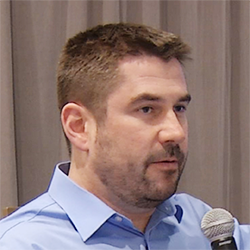Home » Dysautonomias » Live Demonstration Autonomic Function Tests Part 2: Deep Breathing with Patient Jade
Live Demonstration Autonomic Function Tests Part 2: Deep Breathing with Patient Jade
In this video Dr. Singer and Mr. David Sletten demonstrate the deep breathing and heart rate variability test with a sample patient.
Mr. David Sletten: So, first thing that we’re going to do now is, we’re going to set up then for the cardiovagal and adrenergic components. So, the first thing we’re going to do is we’re going to put a chest-bellows on. One of the things that’s important with this is that we are actually looking at those lung receptors. So, we really want to make sure that we’re going over the chest with these. With males, we say to go over the breast, with females we are going just underneath the breast line. What we don’t want to see is them over the stomach. So, we’re really trying to look at those stretch receptors in the lungs. Then you can go head and lie back. Next, what we’re going to do is, we’re going to prep for the ECG electrodes. So, we’ll use a two-step process. We’re going to go first abrade the skin with a little bit of NuPrep. Again, Jade has already shaved for us so we don’t have to do that, but we’ll go over with NuPrep, which is going to abrade the skin and help with that resistance. Then we have an electrode solution called signet spray that we’re actually going to put over those and then finally put the electrodes on top of that.
Mr. Sletten: So, there are numerous beat-to-beat blood pressure devices out there. We’re demonstrating the one that comes with this system, but just know that there are other devices as well. They all kind of have their inherent things that come with the devices. So, each one has a little bit different troubleshooting with it and things like that that you can get that information from the vendors.
Mr. Sletten: We still like to use a standard 3-lead. I do know that there are some ECG devices now that are 4 leads that will automatically switch to the best location or best lead selection. If that’s something you have, go feel free to use it but we like to be able to a manually adjust that as we want to. Then we’re going to start the beat-to-beat blood pressure device, it’s going to inflate the upper arm cuff, get an MVP and then it’s going to try and calibrate the finger sensor cuff to match that as well. And this process takes about a minute and a half, I believe, to two minutes and during that time, we would want our patient to be as still as possible to make sure that we’re not getting a blood pressure higher due to him talking or anything like that.
Dr. Wolfgang Singer: So, you can see that that sequence makes a lot of sense to do the Q-Sweat first, that way the subject is already lying down, we do the deep breathing. By the time you get to the Valsalva maneuver they’ve been laying down at least 30 minutes already and by the time you come to the tilt, they have been laying for 45 minutes already, so that gives you a good baseline naturally.
Mr. Sletten: So now we are picking up the arterial pressure, coming from the finger. Next thing we’ll get an upper arm inflation cuff going. Once that’s done, we’ll be able to start the test.
Mr. Sletten: An hour to 75 minutes, if you have two technicians that’s about an hour. Sometimes if you have the right patient that’s cooperating, that’s maybe done the test before, you might be able to get done a little bit faster but.
Toni: It depends on if you guys are doing ten-minute baselines on that. So, I have been on the research, a lot of times it’s ten, sometimes it’s five. If you’re doing a five-minute baseline your baselines add up but we can do it together, do a pretty good test at hour to an hour to an hour and ten if you take them go to the bathroom and stuff like that but I am going to say and that depends and I think David said if the hands are cold and it takes you 20 minutes to get the feel first, then that can happen.
Mr. Sletten: Obviously cable management here is not ideal from our situation here but we’ll make it work.
Toni: How many do you do? Four in the morning and six in the afternoon?
Dr. Singer: Yeah. We run four labs and do around 20 patients a day, sometimes a little more depending on how quickly it goes and how easy each patient is, we may take an extra but…
Mr. Sletten: So, one of the things that you saw that I did is I positioned the device up here which is going to give us our breathing cue and also the cue for the Valsalva maneuver over the patient. One of the things we don’t want to have, I feel like I am behind, one of the things we don’t want is to have him moving his neck around a lot after the Valsalva so we want to make sure that that’s in a position where he’s not moving around. Again, we’re looking at those neck sensors, the baroreceptors in the neck with this test as well. We would collect a 3-minute baseline. During that time, we would be instructing the patient so I’ll go ahead and do that or Toni do you want to do that?
Toni: So, we’re going to do a series of deep breathing, you going to watch the sign wave. When the green bar is going up, you’ll be inhaling in through your nose, over a course of five seconds all the way up nice big deep chest, breath and then the when the bar goes down, you’re going to blow it out through your mouth. We’re going to do it eight times in a row, I’m going to get a baseline, a resting baseline, and I will tell you when to start and then we’ll do it until I tell you to stop. So, a lot of times when you start to talk to him, their heart rate will go up. So, let them get a nice baseline and then just start, don’t start talking until about “Okay, now we’re going to start doing it” because then their heart rate’s already off and then we’ve got to start over with the baseline.
Mr. Sletten: This is a little different than what we have.
Toni: Yeah, this isn’t the equipment anyway.
Mr. Sletten: We just have a metronome that constantly goes up and down, so it’s actually really easy to instruct our patients because I can actually see how much of a breath they’re going to be taking in and out. This one we will actually get started as soon as we actually tell him okay go ahead and start your breath and then once we hit start it will go up at that point in time. Some another thing is marking the screen. This system does automatically mark for us so it can put a mark at the beginning and the end of the 8 breaths. We like to have it done at the half cycle so that we can actually follow the breath in relation to the chest expansion and know exactly where the peak and valley should be occurring so in some of Dr. Singer’s slides and things maybe later or if you are seeing other presentations of this you might see a mark every 5 seconds with this test, you’re not going to see that. We’ll get started here in just a few seconds. So Jade go ahead and take your big deep breath in.
Toni: I like to do it with them, and I should do all eight.
Dr. Singer: I feel lightheaded afterwards. (Laughing).
Toni: No, I feel really calm.
Mr. Sletten: The other thing is he can use in, in, in to help coach out, out, out is what I like to use, because I like to breathe along with them but it is extremely important that they are getting that maximal breath and so if you not coaching them or if you’re not paying attentions they’ll kind of wander off, right? So, they’ll start out really good and then kind of by about 5, 6 they start trailing off so that is where it is really important as a technician to make sure we’re watching each of those breaths and making sure that they’re getting that full breath.
Toni: I’ve actually had diabetics really wander off and had to call like a respiratory. You need to watch them because if they don’t get it the first couple of times and you’re doing three or four sets and like on a diabetic and somebody that’s watching their CO2 out, you’ll be able to see it on screen, they’ll have nice big deep variations and then they start to get smaller and then they go up like that, and you will have these guys get lightheaded and like I said I have had some issues with diabetics.
Mr. Sletten: You could see it automatically put that mark on the screen at the start and stop for us. On here what you’re looking at is the middle graph is R to R interval which is just an inverse of the heart rate. I do not know how to why? (laughing) What color would you like it? No, I can’t do it when it’s running, it doesn’t look like. And I will be honest I am not as familiar with this version of this software; we use an older version and some home-grown stuff so we are going to rest a little for 3 minutes and then we’re going to repeat that one more time. Some of the other things that are really important is making sure you have the right cuff size so if you’re using the wrong size cuff can either over-read or under-read the blood pressure just like a normal manual blood pressure would do the same thing. We’re at a minute and a half here yet. And these baselines are also very important, some people try to make them a little bit shorter and we find that we want to make sure that we are standardized so everybody is going to the same, have the same wait periods. So, in just a few seconds we’re going to go ahead and do that again. So, go ahead and begin once it starts Jade.
Mr. Sletten: Okay, so then what we would do we would have Jade rest for one additional minute and then we would move on to the Valsalva. I am going to bypass that one minute here just to save a little time for us.

Wolfgang Singer, MD
Associate Professor of Neurology
Mayo Clinic Rochester, MN































